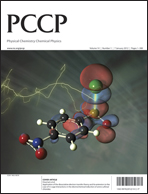卤化硅(100)表面悬键正负电荷态之间的转变
IF 2.9
3区 化学
Q3 CHEMISTRY, PHYSICAL
引用次数: 0
摘要
悬空键(DB)是硅中常见的缺陷,它通过在隙内水平捕获载流子而影响硅的电子性能。扫描隧道显微镜(STM)是探测单个悬空键电子特性的有效仪器。在这里,我们利用 STM 研究了氯化和溴化 Si(100)-2×1 表面上单个 DB 的电荷状态之间的转变。我们观察到了 DB 的正负电荷态之间的跃迁,没有中性态的参与。我们证明,当 DB 和基底状态失去平衡时,就会发生 (+⁄-) 转变。这种转变与电荷中性水平(CNL)有关,它表明 DB 的特性从类供体转变为类受体。发生(+⁄-)转变的 STM 电压随 DB 的静电环境而变化。我们的研究结果补充了对 DB 电子特性的理解,在使用电荷操纵 DB 的应用中应考虑到这些结果。本文章由计算机程序翻译,如有差异,请以英文原文为准。
Transitions between positive and negative charge states of dangling bonds on a halogenated Si(100) surface
Dangling bonds (DBs) are common defects in silicon that affect its electronic performance by trapping carriers at the in-gap levels. For probing the electrical properties of individual DBs, a scanning tunneling microscope (STM) is an effective instrument. Here we study transitions between charge states of a single DB on chlorinated and brominated Si(100)-2×1 surfaces in an STM. We observed transitions between positively and negatively charged states of the DB, without the participation of the neutral state. We demonstrated that the (+⁄-) transition occurs when the DB and substrate states are out of equilibrium. This transition is related to the charge neutrality level (CNL), which indicates a change in the DB’s character from donor-like to acceptor-like. The STM voltage at which the (+⁄-) transition took place varied depending to the electrostatic environment of the DB. Our results complement the understanding of the electronic properties of the DBs, and they should be taken into account in applications that use charge manipulation on the DBs.
求助全文
通过发布文献求助,成功后即可免费获取论文全文。
去求助
来源期刊

Physical Chemistry Chemical Physics
化学-物理:原子、分子和化学物理
CiteScore
5.50
自引率
9.10%
发文量
2675
审稿时长
2.0 months
期刊介绍:
Physical Chemistry Chemical Physics (PCCP) is an international journal co-owned by 19 physical chemistry and physics societies from around the world. This journal publishes original, cutting-edge research in physical chemistry, chemical physics and biophysical chemistry. To be suitable for publication in PCCP, articles must include significant innovation and/or insight into physical chemistry; this is the most important criterion that reviewers and Editors will judge against when evaluating submissions.
The journal has a broad scope and welcomes contributions spanning experiment, theory, computation and data science. Topical coverage includes spectroscopy, dynamics, kinetics, statistical mechanics, thermodynamics, electrochemistry, catalysis, surface science, quantum mechanics, quantum computing and machine learning. Interdisciplinary research areas such as polymers and soft matter, materials, nanoscience, energy, surfaces/interfaces, and biophysical chemistry are welcomed if they demonstrate significant innovation and/or insight into physical chemistry. Joined experimental/theoretical studies are particularly appreciated when complementary and based on up-to-date approaches.
 求助内容:
求助内容: 应助结果提醒方式:
应助结果提醒方式:


